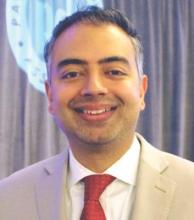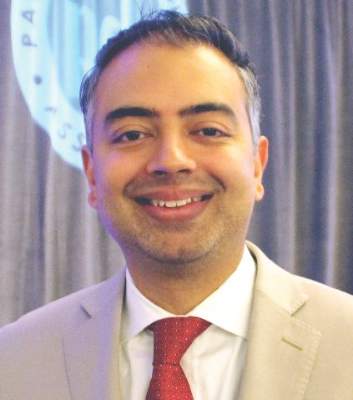User login
NEWPORT BEACH, CALIF. – The way Seemal R. Desai, MD, sees it, becoming a leader in dermatology doesn’t have to involve a huge time commitment.
The effort “can take as little as 5 minutes a week or as much as a few hours a week, depending on your level of interest,” he said at the annual meeting of the Pacific Dermatologic Association. “But I think that we all need to contribute in some way to give back to our specialty, which is constantly under threat from lots of other specialties and other influences.”
He discussed several practical ways to assume a leadership role in the field, such as lecturing to high school, medical school, or even nurse practitioner students; volunteering in the local academic dermatology department or indigent clinic; lobbying local legislative officials; organizing health policy campaigns, or attending events such as the Capitol Hill Skin Cancer Screening and Prevention Health Fair, One Voice Against Cancer (OVAC) Lobby Day, and the American Academy of Dermatology Annual Legislative Conference (held this year in Washington, D.C., Sept. 11-13).
“Your leadership does not have to be in the traditional sense of getting involved in a committee, getting involved on a board, or in your medical society. There are lots of different things we can do to be leaders,” said Dr. Desai, founder and medical director of Plano, Tex.–based Innovative Dermatology.
Resources he highlighted include the AAD’s Leadership Learning Center, which includes videos on topics such as how to talk to legislators, how to review an article for the Journal of the American Academy of Dermatology, and the nuts and bolts of how to run an efficient staff meeting. The site also contains short podcasts on topics such as time management and conflict resolution, and an extensive list of recommended books about leadership, including the New York Times best seller “Quiet: The Power of Introverts in a World That Can’t Stop Talking”(Crown Publishers, 2012), by Susan Cain. “This book highlights some helpful tips on what you can do to make your practice life a lot better in your day-to-day setting,” Dr. Desai said. “That’s really important when we talk about physician burnout.”
He also encouraged dermatologists to become mentors to clinicians entering the field or those in the early stages of their careers. “None of us became leaders without mentors,” said Dr. Desai, who also holds a faculty position in the department of dermatology at the University of Texas Southwestern Medical Center, Dallas. “Being a mentor is a way to advocate for dermatology, because you’re helping someone become a leader, to take our specialty to the next level.” Information about AAD’s mentoring program is available at: www.aad.org/members/leadership-institute/mentoring.
For those inclined to become politically involved, opportunities abound in local, regional, and national dermatology societies, as well as with SkinPAC, the only federal political action committee representing dermatology’s interests, he said. “Advocacy is important to our specialty to make sure that our voices are heard by policymakers at the state and federal level,” Dr. Desai added. “We as dermatologists work hard; we deal with very difficult patients. In fact, studies have shown that we as outpatient physicians are some of the busiest in the entire organized medicine sea. However, people don’t really understand what we as dermatologists do.”
Dr. Desai reported having no relevant financial disclosures.
NEWPORT BEACH, CALIF. – The way Seemal R. Desai, MD, sees it, becoming a leader in dermatology doesn’t have to involve a huge time commitment.
The effort “can take as little as 5 minutes a week or as much as a few hours a week, depending on your level of interest,” he said at the annual meeting of the Pacific Dermatologic Association. “But I think that we all need to contribute in some way to give back to our specialty, which is constantly under threat from lots of other specialties and other influences.”
He discussed several practical ways to assume a leadership role in the field, such as lecturing to high school, medical school, or even nurse practitioner students; volunteering in the local academic dermatology department or indigent clinic; lobbying local legislative officials; organizing health policy campaigns, or attending events such as the Capitol Hill Skin Cancer Screening and Prevention Health Fair, One Voice Against Cancer (OVAC) Lobby Day, and the American Academy of Dermatology Annual Legislative Conference (held this year in Washington, D.C., Sept. 11-13).
“Your leadership does not have to be in the traditional sense of getting involved in a committee, getting involved on a board, or in your medical society. There are lots of different things we can do to be leaders,” said Dr. Desai, founder and medical director of Plano, Tex.–based Innovative Dermatology.
Resources he highlighted include the AAD’s Leadership Learning Center, which includes videos on topics such as how to talk to legislators, how to review an article for the Journal of the American Academy of Dermatology, and the nuts and bolts of how to run an efficient staff meeting. The site also contains short podcasts on topics such as time management and conflict resolution, and an extensive list of recommended books about leadership, including the New York Times best seller “Quiet: The Power of Introverts in a World That Can’t Stop Talking”(Crown Publishers, 2012), by Susan Cain. “This book highlights some helpful tips on what you can do to make your practice life a lot better in your day-to-day setting,” Dr. Desai said. “That’s really important when we talk about physician burnout.”
He also encouraged dermatologists to become mentors to clinicians entering the field or those in the early stages of their careers. “None of us became leaders without mentors,” said Dr. Desai, who also holds a faculty position in the department of dermatology at the University of Texas Southwestern Medical Center, Dallas. “Being a mentor is a way to advocate for dermatology, because you’re helping someone become a leader, to take our specialty to the next level.” Information about AAD’s mentoring program is available at: www.aad.org/members/leadership-institute/mentoring.
For those inclined to become politically involved, opportunities abound in local, regional, and national dermatology societies, as well as with SkinPAC, the only federal political action committee representing dermatology’s interests, he said. “Advocacy is important to our specialty to make sure that our voices are heard by policymakers at the state and federal level,” Dr. Desai added. “We as dermatologists work hard; we deal with very difficult patients. In fact, studies have shown that we as outpatient physicians are some of the busiest in the entire organized medicine sea. However, people don’t really understand what we as dermatologists do.”
Dr. Desai reported having no relevant financial disclosures.
NEWPORT BEACH, CALIF. – The way Seemal R. Desai, MD, sees it, becoming a leader in dermatology doesn’t have to involve a huge time commitment.
The effort “can take as little as 5 minutes a week or as much as a few hours a week, depending on your level of interest,” he said at the annual meeting of the Pacific Dermatologic Association. “But I think that we all need to contribute in some way to give back to our specialty, which is constantly under threat from lots of other specialties and other influences.”
He discussed several practical ways to assume a leadership role in the field, such as lecturing to high school, medical school, or even nurse practitioner students; volunteering in the local academic dermatology department or indigent clinic; lobbying local legislative officials; organizing health policy campaigns, or attending events such as the Capitol Hill Skin Cancer Screening and Prevention Health Fair, One Voice Against Cancer (OVAC) Lobby Day, and the American Academy of Dermatology Annual Legislative Conference (held this year in Washington, D.C., Sept. 11-13).
“Your leadership does not have to be in the traditional sense of getting involved in a committee, getting involved on a board, or in your medical society. There are lots of different things we can do to be leaders,” said Dr. Desai, founder and medical director of Plano, Tex.–based Innovative Dermatology.
Resources he highlighted include the AAD’s Leadership Learning Center, which includes videos on topics such as how to talk to legislators, how to review an article for the Journal of the American Academy of Dermatology, and the nuts and bolts of how to run an efficient staff meeting. The site also contains short podcasts on topics such as time management and conflict resolution, and an extensive list of recommended books about leadership, including the New York Times best seller “Quiet: The Power of Introverts in a World That Can’t Stop Talking”(Crown Publishers, 2012), by Susan Cain. “This book highlights some helpful tips on what you can do to make your practice life a lot better in your day-to-day setting,” Dr. Desai said. “That’s really important when we talk about physician burnout.”
He also encouraged dermatologists to become mentors to clinicians entering the field or those in the early stages of their careers. “None of us became leaders without mentors,” said Dr. Desai, who also holds a faculty position in the department of dermatology at the University of Texas Southwestern Medical Center, Dallas. “Being a mentor is a way to advocate for dermatology, because you’re helping someone become a leader, to take our specialty to the next level.” Information about AAD’s mentoring program is available at: www.aad.org/members/leadership-institute/mentoring.
For those inclined to become politically involved, opportunities abound in local, regional, and national dermatology societies, as well as with SkinPAC, the only federal political action committee representing dermatology’s interests, he said. “Advocacy is important to our specialty to make sure that our voices are heard by policymakers at the state and federal level,” Dr. Desai added. “We as dermatologists work hard; we deal with very difficult patients. In fact, studies have shown that we as outpatient physicians are some of the busiest in the entire organized medicine sea. However, people don’t really understand what we as dermatologists do.”
Dr. Desai reported having no relevant financial disclosures.
EXPERT ANALYSIS AT PDA 2016

